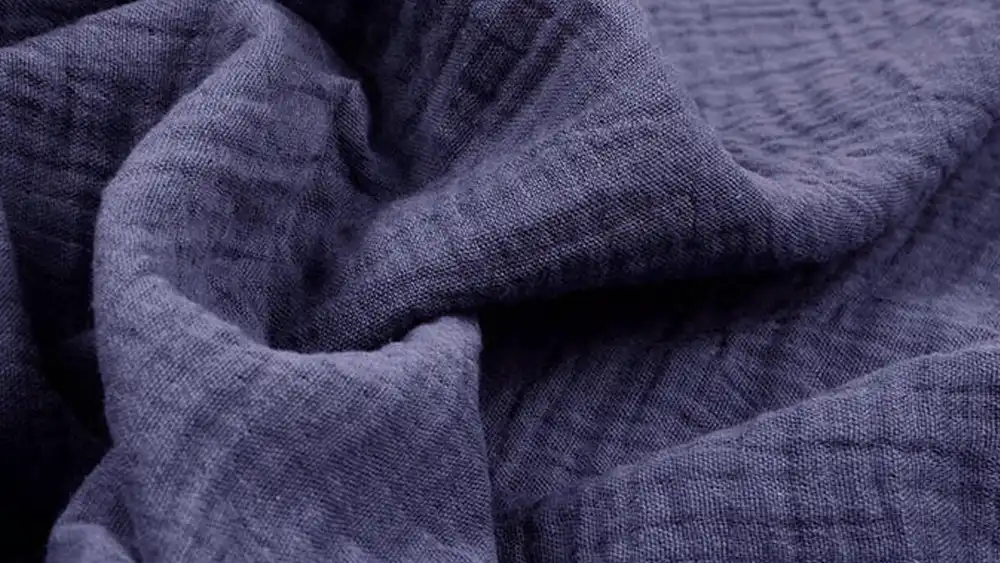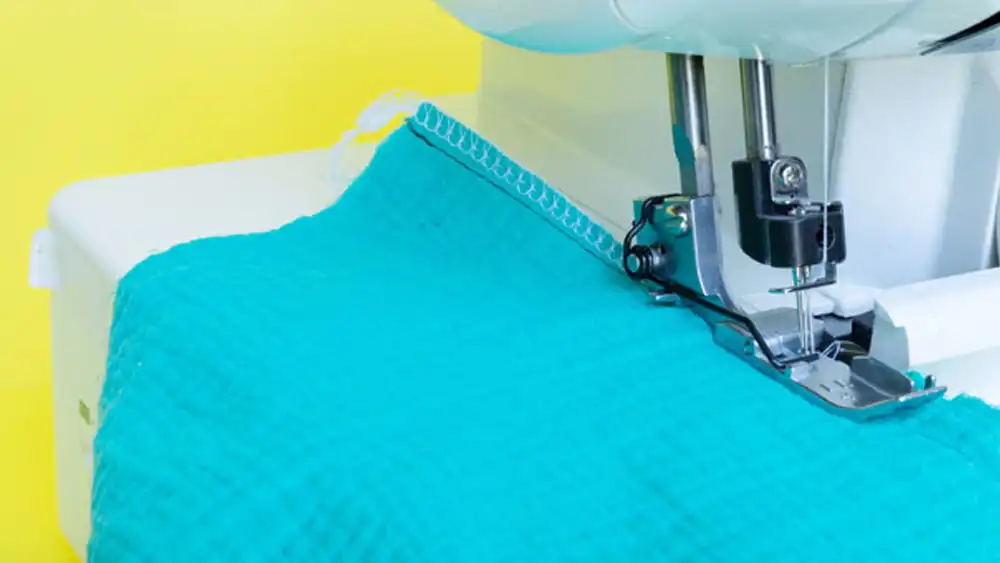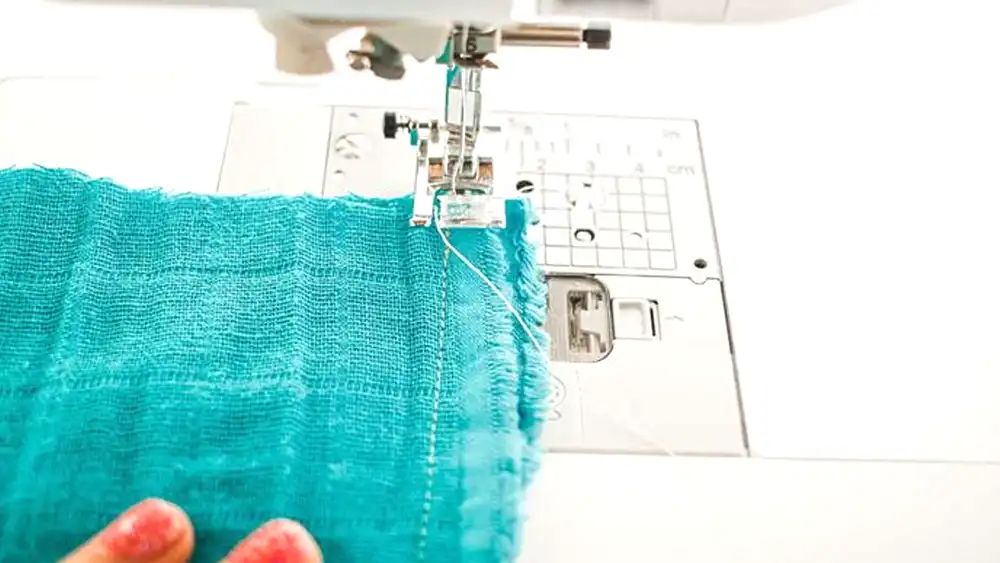Sewing gauze fabric can be a delightful experience with the right tips! Start by pre-washing your gauze to avoid shrinkage. Use a lightweight needle and a longer stitch length to prevent tearing. Pin the fabric gently and consider using a walking foot for smooth feeding.
When hemming, try a rolled hem for a polished look. Lastly, don’t rush; take your time to enjoy the process. Ready to create something beautiful? Dive in and explore how to sew gauze fabric today!
What Is Gauze Fabric?

Gauze fabric is a lightweight, sheer textile known for its open weave and breathable properties. It is typically made from natural fibers such as cotton, although it can also be crafted from silk or synthetic materials. The loose weave of gauze fabric creates a delicate, airy texture that is soft to the touch and allows air to circulate freely.
Gauze fabric is commonly used in medical settings for dressings and bandages due to its absorbency and ability to conform to the body. Additionally, it is popular in fashion and crafting for its versatility and ethereal appearance. Whether used for clothing, decor, or medical purposes, gauze fabric adds a soft and delicate touch to any project.
How To Sew Gauze Fabric?

Sewing with gauze fabric opens up a world of creative possibilities, allowing you to create lightweight and ethereal garments, accessories, and home decor items. However, working with this delicate material requires special attention and care to achieve professional-looking results.
Here is the full guide about how to sew gauze fabric step by step.
Step 1: How To Sew Gauze Fabric: Choose the Right Needle and Thread
When sewing with gauze fabric, it’s essential to select the appropriate needle and thread to ensure smooth stitching. Use a fine or universal needle, preferably size 70/10 or 80/12, to prevent snagging or pulling on the delicate fabric. For thread, opt for a lightweight polyester or cotton thread that matches the color of your fabric.
Step 2: Prepare Your Fabric
Before sewing, prewash and press your gauze fabric to remove any wrinkles and shrinkage. Gently iron the fabric on a low heat setting to avoid stretching or distorting the delicate fibers. If desired, you can also use a fabric stabilizer or spray starch to add stability to the fabric and prevent shifting during sewing.
Step 3: Pin or Baste Your Seams
To prevent the lightweight gauze fabric from shifting or puckering during sewing, it’s helpful to pin or baste your seams in place before stitching. Use fine pins or temporary fabric adhesive to secure the layers together, ensuring smooth and even stitching. Alternatively, you can hand-baste the seams with a long, loose running stitch for added stability.
Step 4: Adjust Your Machine Settings
Set your sewing machine to a straight stitch or a narrow zigzag stitch, depending on your project’s requirements. Lower the tension settings slightly to accommodate the delicate nature of the gauze fabric and prevent puckering or bunching. Test the stitch length and tension on a scrap piece of fabric before sewing your project to ensure optimal results.
Step 5: Stitch Carefully and Slowly
When sewing gauze fabric, take your time and stitch slowly to maintain control and accuracy. Use a light touch on the foot pedal to avoid stretching or distorting the fabric as it moves through the machine. Guide the fabric gently with your hands, keeping the seams straight and even. Backstitch at the beginning and end of each seam to secure the stitches in place.
Step 6: Finish the Seams
After sewing, finish the raw edges of your seams to prevent fraying and add durability to your project. You can use a serger or overlock stitch on your sewing machine to encase the edges, or use a zigzag stitch to neaten the edges. Alternatively, trim the seam allowances with pinking shears to reduce bulk and prevent fraying.
Step 7: Press Your Seams
Finally, press your seams with a low-heat iron to set the stitches and smooth out any wrinkles. Use a pressing cloth or a piece of gauze fabric to protect the delicate fibers from direct heat. Press the seams open or to one side, depending on your project’s requirements, and admire your beautifully sewn gauze fabric creation!
Following these step-by-step guidelines will help you sew gauze fabric with confidence and precision, ensuring professional-quality results every time.
How to Sew Cotton Gauze Fabric?
Sewing with cotton gauze fabric can be a delightful experience, but its delicate, loose weave requires a bit of extra care and preparation. By understanding its unique properties and employing the right techniques, you can ensure your projects turn out beautifully, retaining the fabric’s signature softness and drape.
Step 1: Pre-Wash and Prepare Your Fabric
Cotton gauze is notorious for shrinking, so the most crucial first step is to pre-wash and dry your fabric exactly as you intend to wash the finished garment or item. This prevents future shrinkage and distortion after your project is complete. After washing, gently press the fabric with a warm iron if needed, being careful not to stretch it, to smooth out any excessive wrinkles for easier cutting.
Step 2: Choose the Right Needles and Thread
Given gauze’s delicate nature, opt for a sharp, fine needle to avoid snags and skipped stitches. A universal needle in a smaller size, such as 60/8 or 70/10, or a microtex/sharp needle, works best. For thread, a high-quality all-purpose polyester or cotton thread is suitable, as it will be strong enough without adding unnecessary bulk to the lightweight fabric.
Step 3: Use Appropriate Stitch Settings
To prevent puckering and maintain the fabric’s airy quality, select a longer stitch length on your sewing machine. A stitch length between 2.5mm and 3.5mm is generally recommended. If your machine has adjustable presser foot pressure, slightly reducing it can also help prevent the fabric from stretching as it feeds through.
Step 4: Finishing Seams Neatly
Gauze frays easily due to its open weave, making neat seam finishes essential. French seams are highly recommended for their durability and clean finish, completely enclosing raw edges. Alternatively, a serger (overlocker) can provide a fast and secure finish, or a narrow zigzag stitch can be used if other options aren’t available, but always test tension on a scrap first.
Step 5: Handling and Cutting with Care
When cutting gauze, use sharp fabric shears or a rotary cutter with a new blade. Lay the fabric flat on your cutting surface without stretching it. For very slippery gauze, consider placing a layer of tissue paper underneath to stabilize it. Handle cut pieces gently to avoid stretching or distorting the bias, which can lead to uneven seams.
Tips For Sewing With Double Gauze

1. Pre-Wash Your Fabric
Double gauze fabric can shrink slightly after the first wash. Pre-wash the fabric before starting your project to avoid any unwanted surprises in size. Use a gentle cycle with mild detergent and dry it on a low heat setting.
2. Use a Walking Foot
A walking foot can be very helpful when sewing with double gauze. It helps to feed the fabric layers evenly through the machine, preventing shifting and puckering. This is especially useful for maintaining alignment in seams and hems.
3. Stabilize with Spray Starch
Double gauze can be a bit slippery and challenging to handle. Using spray starch can temporarily stiffen the fabric, making it easier to cut and sew. Apply the spray starch lightly and press the fabric with a warm iron before starting your project.
4. Choose the Right Needle and Thread
Use a fine or universal needle, such as size 70/10 or 80/12, to prevent snagging or tearing the delicate fabric. Opt for a lightweight polyester or cotton thread that matches the color of your fabric for a clean finish.
5. Pin Strategically
Pinning double gauze fabric can help keep it in place as you sew. Use fine pins to avoid leaving noticeable holes in the fabric. Pin at shorter intervals to ensure the layers stay aligned.
6. Adjust Your Stitch Length
Set your sewing machine to a slightly longer stitch length, such as 2.5 to 3.0 mm. This helps to accommodate the fabric’s texture and prevents the stitches from becoming too tight, which can cause puckering.
7. Handle the Fabric Gently
Double gauze is delicate and can stretch out of shape if handled too roughly. Guide the fabric gently through the sewing machine without pulling or tugging. Let the machine do the work of feeding the fabric.
8. Use French Seams
To give your project a polished and professional finish, consider using French seams. This technique encases the raw edges of the fabric, preventing fraying and adding durability. It’s especially useful for garments and items that will be washed frequently.
9. Test on Scrap Fabric
Before you begin your main project, practice on a scrap piece of double gauze. This allows you to adjust your machine settings, stitch length, and tension to achieve the best results without risking your project fabric.
10. Press Seams Carefully
When pressing seams, use a low heat setting and a pressing cloth to protect the fabric. Double gauze can be delicate, and too much heat can damage the fibers. Press gently to set the seams without flattening the fabric’s natural texture.
11. Finish Raw Edges
Double gauze can fray easily, so finishing raw edges is important. Options include serging the edges, using a zigzag stitch, or binding the edges with bias tape for a neat and secure finish.
By following these tips and tricks, you can work with double gauze fabric more effectively and create stunning projects with confidence. Whether you’re making clothing, accessories, or home decor items, these techniques will help you achieve professional-looking results.
Double gauze fabric is a fantastic choice for a variety of sewing projects due to its softness, breathability, and unique texture.
Here are some sewing patterns that work particularly well with double gauze, along with tips on how to choose and use them effectively.
Tips for Sewing Gauze Fabric
Sewing with gauze fabric can be a rewarding experience if you approach it with a few specific considerations in mind. Its delicate, often crinkled texture and propensity to stretch on the bias require a gentle touch and careful handling throughout the entire process. Taking the time for proper preparation and using the right tools will make a significant difference in the final outcome of your project.
Here are some essential tips to ensure success when sewing with gauze fabric:
- Consider French Seams: As mentioned, French seams are highly recommended for gauze as they enclose raw edges, preventing fraying and providing a very clean, professional finish that is ideal for lightweight, sometimes transparent fabrics.
- Stabilize Slippery Fabric: For very sheer or slippery gauze, consider using a temporary fabric adhesive spray, tissue paper, or a starch alternative to add temporary body and make cutting and sewing easier.
- Test Stitches on Scraps: Before sewing your main project, always test your stitch length, tension, and needle on a scrap of your gauze fabric. This helps you fine-tune settings and prevent issues on your actual garment.
- Avoid Excessive Pinning: Pins can snag or leave permanent marks on delicate gauze. Use fewer pins, or opt for fabric clips, which are gentler and won’t pierce the fabric.
- Use a Walking Foot: A walking foot attachment can be incredibly helpful for gauze as it feeds both layers of fabric evenly, preventing stretching and shifting, especially on longer seams.
- Press Gently: When pressing seams, use a warm iron and a pressing cloth, and press gently. Avoid pushing or dragging the iron, as this can distort the fabric. Allow seams to cool completely before handling.
Conclusion
In conclusion, mastering how to sew gauze fabric opens up a world of creative possibilities. By following these tips—like pre-washing, using the right needle, and employing techniques such as a rolled hem—you can achieve stunning results with this delicate material.
Whether you’re crafting lightweight garments or airy home decor, gauze fabric is versatile and beautiful. Ready to get started? Quote gauze fabric from us today and let your creativity soar with our high-quality selection!
FAQ
Is gauze fabric easy to sew?
Gauze can be a challenge to sew. It frays easily, so use a serger or zig-zag stitch to prevent raveling. Adjust your machine for a longer stitch length and lighter presser foot pressure for smoother results.
What is the best thread for gauze fabric?
For strong, smooth seams on gauze, choose a 50wt cotton or polyester thread. This weight offers a good balance between strength and manageability. Avoid thicker threads that might show through the airy fabric.
Should you wash double gauze before sewing?
Yes, pre-washing double gauze is crucial! It allows for shrinkage, ensuring your finished project fits as planned. Washing also softens the fabric and removes any sizing that might affect sewing.
What is gauze fabric used for?
Gauze’s versatility is amazing! It’s a favorite for breezy summer clothing, like dresses and shirts. Medical professionals use it for bandages due to its absorbency. Gauze also adds a soft touch to home decor projects like curtains and throws.
Is cotton gauze hard to sew?
Cotton gauze can be trickier to sew than some fabrics. Its loose weave tends to fray. However, with the right techniques (like serging) and machine adjustments, you can still create beautiful projects with this soft, breathable material.
